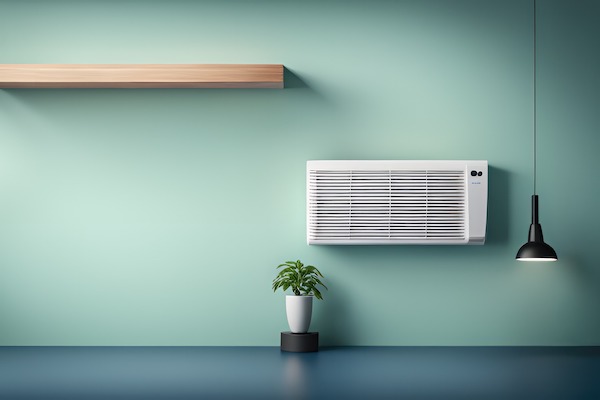The Importance of Good Indoor Air Quality

Good indoor air quality is essential to maintaining excellent health and can be achieved through a holistic approach of source control plus adequate ventilation to remove pollutants.
A recent high-profile case on the impact of mould which has raised awareness with building and dwelling occupiers over the importance of Indoor Air Quality and is taking an increasing role in improving the welfare of occupiers and should be considered equally alongside improvements in energy efficiency.
External pollutants
Common external pollutants such as sulphur dioxide (SO2), nitrogen dioxide (NO2) and particulate matter (PM) can cause respiratory issues, asthma plus heart and pulmonary disease amongst others.
The ingress of external pollutants can be reduced by installing high-efficiency air filters in ventilation systems to help remove a significant portion of particulate matter from the incoming outdoor air and positioning air intakes away from major pollution sources like roads, factories, or parking lots. Additionally, optimizing building orientation and layout can help reduce exposure to pollutants.
Whilst these measures can help reduce the impact of external pollutants, achieving optimal indoor air quality also requires addressing internal pollution sources such as volatile organic compounds (VOCs), cleaning agents, and building materials.
Internal pollutants
Common indoor pollutants can have various effects on indoor air quality and the health of occupants:
1. Gas Cookers and Fires: Incomplete combustion of gas or solid fuels can release carbon monoxide (CO), nitrogen dioxide (NO2), and other harmful gases. These pollutants can cause respiratory issues, headaches, and in severe cases, even death.
2. Perfumes, Scented Candles, and Incense: These products often contain volatile organic compounds (VOCs) that can contribute to indoor air pollution. Prolonged exposure to high levels of VOCs may lead to eye, nose, and throat irritation, headaches, and allergic reactions.
3. Detergents, Deodorants, and Paints: Some cleaning products, personal care items, and paints can emit VOCs and other chemicals, contributing to poor indoor air quality. Prolonged exposure to high levels of VOCs can cause respiratory irritation, allergic reactions, and may contribute to the development of asthma.
4. Mould and Damp: Mould growth in damp environments can release spores and mycotoxins, which can trigger allergic reactions, asthma symptoms, and respiratory issues in sensitive individuals.
5. Modern Furnishings and Laminates: Some modern furnishings and laminates may emit VOCs, including formaldehyde, which can cause irritation of the eyes, nose, and throat, and may contribute to the development of respiratory conditions.
When these common pollutants are present in combination, their impacts can be additive or even synergistic, potentially leading to more severe health effects.
The severity of the impacts can vary depending on factors such as the concentration and duration of exposure, individual sensitivity, and overall ventilation and air exchange rates in the indoor environment.
To maintain good indoor air quality, it is advisable to address and minimize the sources of these pollutants, ensure proper ventilation, and use environmentally friendly and low VOC products whenever possible.
Mitigation strategies
A number of strategies can be used to mitigate the presence of internal pollutants:
1. Adequate Ventilation: Proper ventilation is crucial in reducing the concentration of indoor pollutants. Buildings should have well-designed ventilation systems that bring in outdoor air and remove stale air. Mechanical ventilation systems with air filters can help in removing particulate matter and some gases.
2. Implement Energy Recovery Systems: Use energy recovery systems such as heat exchangers or enthalpy wheels to recover and reuse energy from the exhaust air. This can help reduce the energy consumption of the ventilation system.
3. Consider Indoor Air Quality Sensors: Install indoor air quality sensors to monitor and control ventilation based on real-time air quality measurements. This allows for dynamic adjustments to the ventilation system, optimizing air quality while minimizing energy consumption.
4. Implement Demand-Controlled Ventilation: Utilize demand-controlled ventilation strategies that adjust ventilation rates based on occupancy or pollutant levels. This can help optimize energy usage while maintaining good indoor air quality.
5. Air Filtration: Installing high-efficiency air filters in ventilation systems can help capture and remove particulate matter and some gases.
6. Air Cleaning Technologies/Purification: Air cleaning technologies can target specific pollutants, such as volatile organic compounds (VOCs), bacteria, viruses, or odours. They can enhance IAQ by reducing the concentration of these pollutants, leading to improved health and comfort.
7. Humidity Control: Maintaining appropriate humidity levels can help prevent mould growth. Buildings should have proper moisture management systems in place, including dehumidifiers and adequate insulation to prevent condensation.
8. Radon Mitigation: Radon is a radioactive gas that can seep into buildings through the ground. Measures such as sealing cracks in the foundation, installing a vapour barrier, and using radon mitigation systems can help reduce radon levels.
9. Regular Maintenance: Regularly inspecting and maintaining HVAC systems, exhaust vents, and other equipment is essential to ensure proper functioning and minimize the chance of indoor pollutant build-up.
10. Education and Awareness: Educating occupants about indoor air quality and promoting good habits such as proper ventilation, regular cleaning, and avoiding smoking indoors can contribute to a healthier indoor environment.
Achieving good IAQ
The negative impact on health caused by pollutants can be mitigated against by the dual approach of source control and implementing a ventilation strategy to ensure the provision of good IAQ.
Specific measures required to mitigate internal pollutants may vary depending on the building type, its usage, and the specific pollutants of concern.
Some ventilation, filtration, or air cleaning technologies may increase energy usage. Therefore, it is important to balance the energy requirements with the IAQ improvements to ensure overall efficiency.
Consulting with HVAC professionals, IAQ experts, and considering life-cycle costs can help determine the most suitable options and strike a balance between cost and benefit for improving indoor air quality to suit each building's unique needs.



.JPG)


